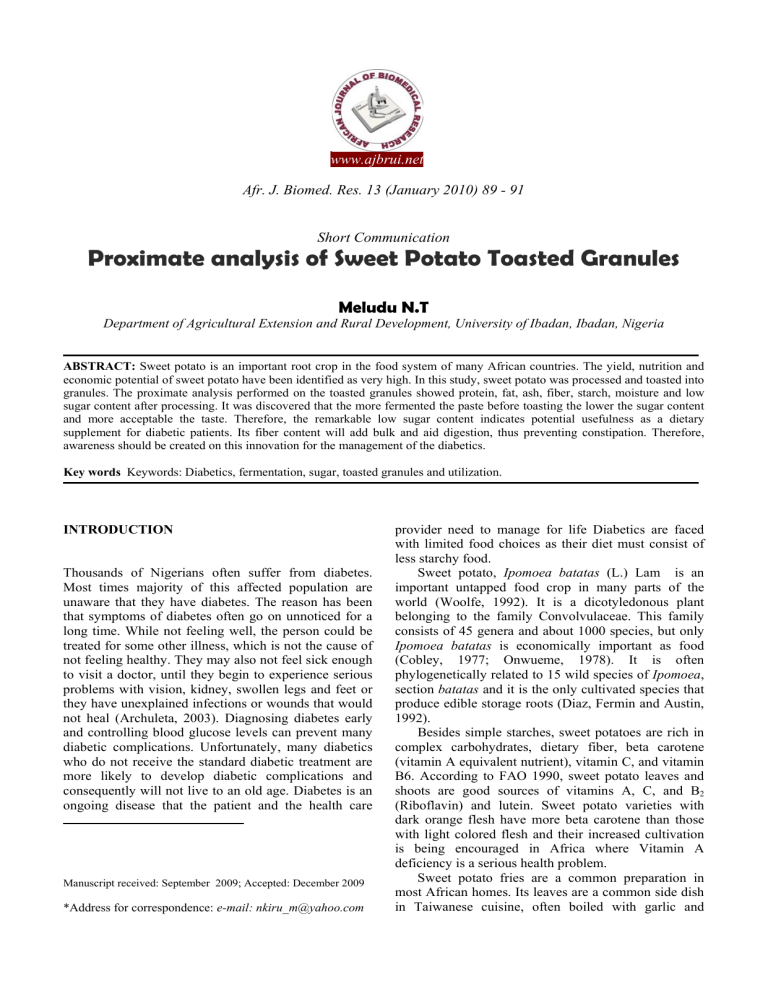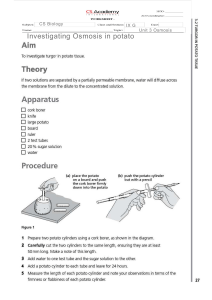Sweet Potato Toasted Granules: Proximate Analysis & Diabetic Diet
advertisement

www.ajbrui.net Afr. J. Biomed. Res. 13 (January 2010) 89 - 91 Short Communication Proximate analysis of Sweet Potato Toasted Granules Meludu N.T Department of Agricultural Extension and Rural Development, University of Ibadan, Ibadan, Nigeria ABSTRACT: Sweet potato is an important root crop in the food system of many African countries. The yield, nutrition and economic potential of sweet potato have been identified as very high. In this study, sweet potato was processed and toasted into granules. The proximate analysis performed on the toasted granules showed protein, fat, ash, fiber, starch, moisture and low sugar content after processing. It was discovered that the more fermented the paste before toasting the lower the sugar content and more acceptable the taste. Therefore, the remarkable low sugar content indicates potential usefulness as a dietary supplement for diabetic patients. Its fiber content will add bulk and aid digestion, thus preventing constipation. Therefore, awareness should be created on this innovation for the management of the diabetics. Key words Keywords: Diabetics, fermentation, sugar, toasted granules and utilization. INTRODUCTION1 Thousands of Nigerians often suffer from diabetes. Most times majority of this affected population are unaware that they have diabetes. The reason has been that symptoms of diabetes often go on unnoticed for a long time. While not feeling well, the person could be treated for some other illness, which is not the cause of not feeling healthy. They may also not feel sick enough to visit a doctor, until they begin to experience serious problems with vision, kidney, swollen legs and feet or they have unexplained infections or wounds that would not heal (Archuleta, 2003). Diagnosing diabetes early and controlling blood glucose levels can prevent many diabetic complications. Unfortunately, many diabetics who do not receive the standard diabetic treatment are more likely to develop diabetic complications and consequently will not live to an old age. Diabetes is an ongoing disease that the patient and the health care Manuscript received: September 2009; Accepted: December 2009 *Address for correspondence: e-mail: nkiru_m@yahoo.com provider need to manage for life Diabetics are faced with limited food choices as their diet must consist of less starchy food. Sweet potato, Ipomoea batatas (L.) Lam is an important untapped food crop in many parts of the world (Woolfe, 1992). It is a dicotyledonous plant belonging to the family Convolvulaceae. This family consists of 45 genera and about 1000 species, but only Ipomoea batatas is economically important as food (Cobley, 1977; Onwueme, 1978). It is often phylogenetically related to 15 wild species of Ipomoea, section batatas and it is the only cultivated species that produce edible storage roots (Diaz, Fermin and Austin, 1992). Besides simple starches, sweet potatoes are rich in complex carbohydrates, dietary fiber, beta carotene (vitamin A equivalent nutrient), vitamin C, and vitamin B6. According to FAO 1990, sweet potato leaves and shoots are good sources of vitamins A, C, and B2 (Riboflavin) and lutein. Sweet potato varieties with dark orange flesh have more beta carotene than those with light colored flesh and their increased cultivation is being encouraged in Africa where Vitamin A deficiency is a serious health problem. Sweet potato fries are a common preparation in most African homes. Its leaves are a common side dish in Taiwanese cuisine, often boiled with garlic and Proximate analysis of sweet potato vegetable oil and dashed with salt before serving. The young leaves and vine tips of sweet potato plants are widely consumed as a vegetable in West African countries (for example Guinea, Sierra Leone and Liberia), as well as in north eastern Uganda and East Africa (Abidin, 2004). Steamed/Boiled chunks are also very common in many African homes used as a simple, healthy snack. Sweet potato chips can be sliced, fried, and eaten just like potato chips or French fries. Raw sweet potatoes can be eaten as well, usually as a chip. In previous studies, sweet potato was processed into different confectioneries (Meludu, 2009) and a suggestion made to establishing sweet potato cottage industry in Nigeria. In this study, an attempt is made at broadening the choice of food for diabetic patients by processing sweet potato through fermentation and toasting the granules MATERIAL AND METHOD The materials used in this study include sweet potato roots, empty rice bag, peelers/knives, bowls and the processing technologies used. Sweet potato vines were cultivated and tubers harvested by a final year student of Agronomy Department University of Ibadan, Nigeria. Procedure for processing sweet potato into toasted granules • Sweet potato roots were peeled manually (peels were given to livestock). • Peeled roots were then washed. • Washed peeled the roots were then sent for grating. • After grating, the grated roots were put into an empty washed rice bag. • The sweet potato paste was fermented for 24 hours before toasting (To achieve a better taste and reduced sugar content, the grated roots can be left in the rice bag for 1-3 days or toasted the same day to achieve a sugary taste). • The bag was then put in the jack press to press out the water in the grated roots (the water could be allowed to settle and the starch collected. • The granules were sifted to remove chaff before toasting (sifted particles were given to livestock). • The sifted granules are now ready to be toasted. • The toasted granules are sifted again to remove the bigger granules so that only fine toasted granules are left. The granules were taken to the International Institute for Tropical Agriculture (IITA), Ibadan for proximate analysis and was further re-analyzed at the National 158 Institute for Science and Laboratory Technology (NISLT), Ibadan Nigeria. RESULTS AND DISCUSSION The results (nutrient content) of the proximate analysis of the toasted sweet potato granules are indicated in Table 1. The results of this study showed that there are differences in the nutrient content of the toasted granules, after several confirmations. These are against the nutrient content in raw sweet potato of 6% sugar, 4 % fiber and 17% starch per 100 gram (Jegtvig, 2008). Boiled sweet potato roots contain 5.7% sugar, which is higher than the sugar in toasted granules. The implication is that the sugar content is reduced after processing through fermentation and toasting the granules. The sugar content of the roots is reduced by an increase in the time of fermentation, while the fiber content increased. Table 1: Percentage of the nutrient content of sweet potato toasted granule per 100gm Protein % Fat % Fiber % Sugar % Sweet Potato Toasted granules 1.76 0.25 6.65 0.30 Boiled Sweet Potato 1.65 1.0 1.8 5.70 Raw Sweet Potato 1.65 0 4.0 6.00 There are immense potential qualities in sweet potato to serve as diet supplement for good health in general and for the diabetics in particular, because of the lower sugar content after being processed into toasted granules. In general it has been established that sweet potato contains low sugar. Unfortunately most consumers have depended so much on cassava another root and tuber crops, which would require serious intervention to convince them on this innovation to change their consumption pattern to include sweet potato. Even though nutritional and agricultural knowledge is available, the information is not always transferred to the majority of the consumers. The consumers are also not aware of the different forms of processing sweet potato. It is therefore recommended that sweet potato multiplication programs be established, focusing on improved and orange flesh varieties. Awareness shoukd also be created to inform the consumers on the nutrient content of sweet potato, especially its health benefits as a candidate for supplementing diabetic meal is urgently required. Afr. J. Biomed. Res. Vol. 13, No. 1, 2010 Meludu NT Proximate analysis of sweet potato REFERENCES Achuleta, Martha 2003. Control your diabetes for life. Collage of Agriculture and HomeEconomics. Published by New Mexico State University, Department of Health and Diabetes Control. Pp. 569b-j. Meludu, N.T.; C.G. Ajala and M.O. Akoroda 2003. Poverty alleviation through the processing of sweet potato tubers into toasted granules and consumer preferences in Nigeria. African Journal of Root and Tuber Crops. Vol. 5 No.2: 56 59. Woolfe, J.A., 1992. "Sweet potato: an untapped food resource", Cambridge Univ. Press and the International Potato Center (CIP). Cambridge, UK. Cobley, L. S. 1977. An introduction to the botany of tropical crops. Longman Group Limited, London. pp. 111 – 115. Onwueme, I. C. 1978. The tropical tuber crops (Yams, Cassava, Sweet potato, Cocoyam). University of Ife, Ile Ife, Nigeria. pp. 167 – 194. Diaz, J.; Fermin dela. P. and Austin, D. F. 1992. Enlargement of fibrous roots in ipomoea batatas (Convolvulaceae). Economic Botany 46 (3): 322 – 329 Bashaasha, B.; Nwanga, R. O. M.; P’Obwoya, C. O. and Enwell, P. T. 1995. Sweet potato in the farming and food systems of Uganda. pp. 225 – 228. Zhang, D.P., M. Ghislain, Z. Huamán, J.C. Cervantes and E.E. Carey 1998. AFLP assessment of 159 sweet potato genetic diversity in four tropical American regions. CIP Program Report 1997-1998, pp. 303-310. Ewell, P.T. and Mutrura, J. 1991. Sweet potato in the food system of Eastern and Southern Africa. Proceeding of the International Symposium of the International Society for Tropical Root and Tuber Crops pp. Oyeniyi, B.O.; Adekoya, A.E. and Meludu, N.T. 2004: Potential of Sweetpotato in Livestock Farming: Implication for Technology Transfer. African Journal of Livestock Extension Vol.3. 33-35. Abidin, P.E. 2004. Sweet potato breeding for northeastern Uganda: Farmer varieties, farmerparticipatory selection, and stability of performance. PhD Thesis, Wageningen University, The Netherlands, 152 pp. ISBN 908504-033-7. FAO 1990. Sweet potato leaves and shoots are a good source of vitamins A, C, and B2 (Riboflavin), leaflet No. 13. Horton, D.E; Prain, G.; Gregory, P. 1989. High level investment for global sweet potato research and developments CIP Circular, 17(3). Austin, D.F. 1988. The taxonomy, evolution and genetic diversity of sweet potatoes and related wild species. In: P. Gregory (ed.). Exploration, maintenance, and utilization of sweet potato genetic resources, pp. 27-60. CIP, Lima, Peru. Meludu, N.T. 2004. Socio-economic potentials of sweet potato cultivation in Nigeria. Ibadan Journal of Agriculture, Nigeria. Afr. J. Biomed. Res. Vol. 13, No. 1, 2010 Meludu NT





